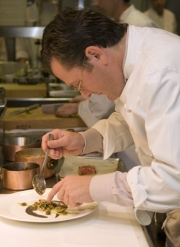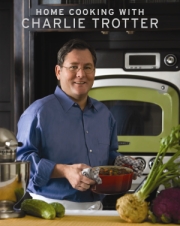Chef Charlie Trotter is famous for his love of tasting menues and when he adds in his love of wine and skills in matching them to his food he brings you to a new level of dining experiences.
After graduating from the University of Wisconsin, Trotter decided to eschew a formal culinary education and instead dove into kitchen work with the goal being as hands-on as possible (One Trotter tale was a job he held in New York, where his shift began at 4 p.m. Trotter reported to work promptly at 10 a.m. every morning and worked straight through). “I like the idea of teaching yourself,” he said. “At the time I was working like a fiend because I wanted access to the best possible food items and the best possible people…that’s all I have ever been interested in.” Soon after, Trotter began to feel that perhaps Europe had that “best” that he was seeking so he went on a culinary trek “to dine at the world’s finest restaurants and learn how they got that distinction.” This trek took him through the best dining rooms in Europe, but one dinner had such a profound effect on him, that the experience resonates within him even today. “I learned that truly great restaurants are about so much more than just gastronomy,” he said. “They must elevate every facet so that the experience is so much more than the sum of the parts. It really crystallized for me when I ate at Restaurant Girardet. It was very organic and I don’t mean the [organic] ingredients. I liked the fluidity and the naturalness of the food. I wanted to model my restaurant after Girardet.”
Entrees: The Menu and the Makings of the Menu
It was also this experience that led to his love affair with the tasting menu–for those who have had the pleasure of dining at any of his restaurants will attest, the chances of getting the same dish twice on two subsequent visits are virtually non-existent.
“I always thought it was more interesting to eat many, many things over the course of the dining experience rather than an appetizer, and an entrée and a dessert,” Trotter said. “Lets say the entréewhether its a big piece of turbot or a big steak, youre kind of getting the same thing over and over again. Heres a bite of steak and another bite and another. I like the steak, but I would rather have lots of things leading up to it and lots of things leading away from it subsequently.”
Any seating at Charlie Trotters features the aforementioned “leading up and leading away” menu style. The namesake flagship opened in 1987 with an initial mission to create the “more than the sum of the parts” mantra he adopted from the trek to Europe. “We wanted to create an experience so that when one is leaving, they say: ‘We expected a lot and this surpassed all of those expectations.’ And that is the same mission today.”
“Its like climbing Everest,” he continued. “Lets say in 23 years weve gone 96 percent up the mountain and in another 23 years well maybe make it another two percent.”
 “Because the higher you go, the thinner the air and the more energy it takes. So you can never grow tired with the quest.”
“Because the higher you go, the thinner the air and the more energy it takes. So you can never grow tired with the quest.”
In his quest for the “best” Trotter has cultivated a small fleet of purveyors that supply him with the best ingredients available. From French truffles to suckling pigs to boutique farm vegetables, any and all are a mere phone call away—a factor that is contingent and paramount for the esteemed reputation that he has created. “Well, any great chef will tell you that 90 percent of it is the ingredients. It isn’t some magical technique or some unbelievable combination of items, it is about the ingredients,” he said. “But 85 percent of our product is organic or naturally grown. All of the meat, game and game birds are hormone-free, antibiotic-free, naturally raised animals. All of the fish is day boat fish and the produce is as organic and natural as we can get.”
“Like I said, its about the product and the sourcing of it,” he continued. “A lot of this product comes from small, artisan growers who are fanatical about their product and wont just give it to anyone who can pay for it. They want to make sure this stuff is going to end up in the right hands and be cared for as they do. With those type products were simply trying to celebrate the flavors.”
Dessert: Philanthropy and the Giving Back

When the chefs hat comes off, it is perhaps his community support that Trotter is known for best. The awards, accolades and recognitions for his philanthropy nearly rival the awards he has won for his food and restaurants and range from the culinary community at large to the federal government. “I do a lot because I want to do a lot and I am in a position to do a lot,” Trotter said. “But I think anyone who is drawn to this world of food, wine and serviceits kind of in your nature to want to do things for people. Youre doing one of the most intimate things you can for another person in feeding them.”